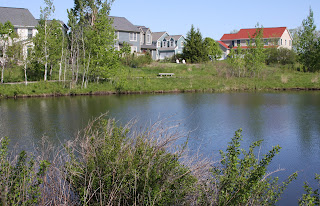“The study, led by Oregon Sea Grant Extension’s invasive species expert Sam Chan, was presented at this week’s national meeting of the Ecological Society of America in Portland.‘Live organisms are a critical element for learning and we don’t want to imply that they should not be used in the classroom,’ said Chan. ‘But some of our schools – and the biological supply houses that provide their organisms – are creating a potential new pathway for non-native species to become invasive.’”
Category:
Classroom specimens require caution and care to prevent becoming invasives
August 14th, 2012 by Irene MilesKimiko Pettis wins Sea Grant PPCP Stewardship Award for classroom PPCP projects
August 7th, 2012 by Irene MilesLocal water travels a long, long way
June 25th, 2012 by Irene MilesWatersheds are areas where water comes together and drains to a common place. In addition to the streams and rivers and creeks that we can see, though, watersheds encompass a huge range of pathways for water, and your nearby water supply might be part of a very large system that spans multiple states.
“Of course, obtaining sustainable development in town isn’t enough, in and of itself, to guarantee high quality, fishable and swimmable rivers and streams. Industry plays a part; utilities and waste water treatment plants play a part; sensitive farming, ranching, and/or timbering play a part, all in different proportions depending upon the particular watershed in question.”
Sea Grant message reaches many thousands in Times Square — The Movie
April 23rd, 2012 by Irene Miles
In partnership with the American Veterinary Medical Association, the Sea Grant program created a 15-second public service announcement that aired on the CBS JumboTron “Super Screen” on 42nd St. in New York City from late December through March.
Recent News
- IISG’s Eliana Brown wins 2025 Illinois Extension Excellence Award
- We’re hiring eight interns for summer 2026
- In 2026, IISG intends to fund 10 research projects focused on coastal concerns
- IISG looks back on 30 years of AIS outreach
- New step-by-step guide and veterinary brochures expand UnwantedMeds.org resources
IISG Instagram
This season, let’s teach eco-friendly habits while spreading cheer! NOAA’s Greener Holiday Gift Guide is full of ideas to reduce waste and protect our precious water resources.
Check out the full guide at the link in bio.
#teachingtuesday
NOAA Marine Debris
NOAA Education

The gales of November may come early, but, as usual, the nominations for the Lakies are right on time along with our official call for nominations!
Brought to you by the Teach Me About the Great Lakes podcast, The Lakies (aka "quite possibly not the least prestigious Great Lakes-focused awards ceremony there is”) are back.
Our goal isn`t to be the Official Arbiters of Quality, but to host a fun celebration of amazing Great Lakes-related research, outreach, and communication in the inimitable Teach Me style.
Nomination categories are:
-Great Lakes Science Communication of the Year
-Great Lakes Outreach Program of the Year
-Great Lakes News Event of the Year
-Great Lakes Research Finding of the Year
-Coolest Thing You Learned Listening to TMATGL in 2025
-Science Podcast of the Year (Non-TMATGL edition)
-Great Lakes Animal of the Year
-Great Lakes Non-Animal of the Year
-Great Lakes Sandwich of the Year
-Great Lakes Donut of the Year
The Details:
-Deadline: Nominations close on December 4th.
Process: It`s easy (just enter the name/title and a link).
-Self-Nominations: Highly encouraged. Don`t be shy.
We’d love to get a broad swath of work across both the serious and less-serious categories to celebrate. Feel free to pass the link on to interested people: https://bit.ly/Lakies25

Making Sense of Social Media: Presented by Illinois-Indiana Sea Grant & Purdue Extension
When: December 6, 2025, from 1 - 4:00 PM EST
Where: RDM Shrimp, RDM Shrimp, 101 N 850 E, Fowler, IN 47944
Registration Link in bio.
Social media can be a great way to market your small business and products, but sometimes it might feel like you are casting a net again and again to find that your net is empty. After all, the point of using social media marketing is to connect with customers. By attending this workshop, you will:
-Hear Research Findings
-Participate in an Interactive Workshop Session
-Learn Real World Application
-Tour a Shrimp Farm
-Network at the “After Hour Social”
This program is supported by the North Central Regional Aquaculture Center and put on in partnership with the Indiana Aquaculture Association Inc, RDM Shrimp, and Ohio Sea Grant, The Ohio State University.
For questions contact Amy Shambach by email (ashambac@purdue.edu) or phone (317-238-0511)

This fall, our team took advantage of several opportunities to showcase our engaging educational programs at outreach events.
One highlight included the Great Plankton Race, where participants built plankton models and tested various adaptations that help this vital part of the food web survive.

Categories
- Aquaculture
- Aquatic Invasive Species
- Buoys
- Climate Ready Communities
- Coastal Resilience
- Director's Blog
- Education
- Featured
- Fellowships
- Fisheries
- Funded Research
- Funding
- Great Lakes Cleanup
- Great Lakes Data
- Healthy Waters
- Internships
- Jobs
- K-12 Education
- News
- Photos
- Program
- Recreation & Tourism
- Resources
- Sea Grant Scholars
- Stormwater & Green Infrastructure
- Sustainable Community Planning
- The Helm
- Uncategorized
- Video
- Water Resource Economics

